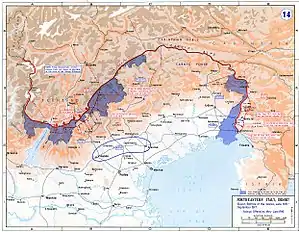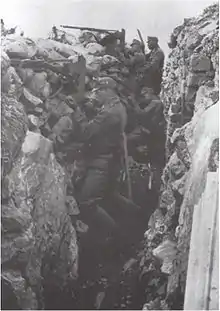First Battle of the Isonzo
The First Battle of the Isonzo was fought between the Armies of Italy and Austria-Hungary on the Italian Front in World War I, between 23 June and 7 July 1915.
| First Battle of the Isonzo | |||||||
|---|---|---|---|---|---|---|---|
| Part of the Italian Front (World War I) | |||||||
 Eleven Battles of the Isonzo June 1915 — September 1917 | |||||||
| |||||||
| Belligerents | |||||||
|
|
| ||||||
| Commanders and leaders | |||||||
|
|
| ||||||
| Strength | |||||||
|
225,000: (18 divisions 252 battalions 111 cavalry squadrons 700 guns) |
115,000: (8 divisions 84 battalions 13 cavalry squadrons 356 guns) | ||||||
| Casualties and losses | |||||||
| 15,000[1] | 10,000[1] | ||||||
The aim of the Italian Army was to drive the Austrians away from its defensive positions along the Isonzo (Soča) and on the nearby mountains.
Although the Italians enjoyed a 2:1 numeric superiority, their offensive failed because the Italian commander, Luigi Cadorna, employed frontal assaults after impressive (but short) artillery barrages. The Austro-Hungarians had the advantage of fighting from uphill positions barricaded with barbed wire which were able to easily resist the Italian assault.
The Italians had some early successes. They partially took Monte Nero (Monte Krn), took Monte Colowrat, and captured the heights around Plezzo. However, they were unable to dislodge the Austro-Hungarian troops from the high ground between Tolmino and the Isonzo, which would later form a launching off point for the Caporetto Offensive. The heaviest fighting occurred around Gorizia. In addition to the natural defenses of the river and mountains, bastions were created at Oslavia and Podgora. The fighting at Gorizia consisted of street-by-street urban combat interspersed with artillery fire. Italian troops, such as the Italian Re and Casale Brigades, were able to advance as far as the suburbs but could get no further and were driven back. They made small footholds at Sagrado and Redipuglia on the Karst Plateau south of Gorizia but were unable to do much else.
On the Austrian-Hungarian side two commanders distinguished themselves: Major General Géza Lukachich von Somorja, commander of the 5th Mountain Brigade, who retook Redipuglia, and Major General Novak von Arienti who retook Hill 383 (overlooking Plave) with his 1st Mountain Brigade.
Early in July the commander of the Austro-Hungarian Fifth Army, General Svetozar Boroević, received two reinforcement divisions, which put an end to the Italian efforts at breaking through the Austro-Hungarian lines.
The final Italian gains were minimal: in the northern sector, they conquered the heights over Bovec (Mount Kanin); in the southern sector, they conquered the westernmost ridges of the Kras plateau near Fogliano Redipuglia and Monfalcone.
Involved units
| Austria-Hungary | ||||
| 5th Army | ||||
| VII Corps | XVI Corps | XV Corps | ||
| 1st Infantry Division | 57th Infantry Division | 61st Infantry Division | 20th Infantry Division | 58th Infantry Division |
| 17th Infantry Division | 18th Infantry Division | 50th Infantry Division | ||
| 187th Infantry Brigade | 6th Mountain Brigade | 16th Mountain Brigade | 14th Mountain Brigade | 81st Honvéd Infantry Brigade |
| 39th Honvéd Infantry Brigade | 2nd Mountain Brigade | 12th Mountain Brigade | 5th Mountain Brigade | 4th Mountain Brigade |
| 10th Mountain Brigade | 1st Mountain Brigade | 13th Mountain Brigade | 7th Mountain Brigade | 15th Mountain Brigade |
| 8th Mountain Brigade | 3rd Mountain Brigade | |||
| Reserve | ||||
| 93rd Infantry Division | ||||
| Headquarters | ||||
| VII Corps in Kostanjevica | XVI Corps in Dornberg | XV Corps in Kneža |
| Italy | ||||
| 2nd Army | 3rd Army | |||
| VII Corps | X Corps | XI Corps | VI Corps | II Corps |
| IV Corps | ||||
| 13th Infantry Division | 14th Infantry Division | 20th Infantry Division | 19th Infantry Division | 21st Infantry Division |
| 12th Infantry Division | 11th Infantry Division | 4th Infantry Division | 3rd Infantry Division | 32nd Infantry Division |
| 7th Infantry Division | 8th Infantry Division | Bersaglieri Division | Alpini Group A and B | half 29th Infantry Division |
| Reserve | ||||
| XIV Corps | ||||
| half 29th Infantry Division | 22nd Infantry Division | 28th Infantry Division | 30th Infantry Division | 23rd Infantry Division |
| 27th Infantry Division | 33rd Infantry Division | 1st Cavalry Division | 2nd Cavalry Division | 3rd Cavalry Division |
| Commanders | ||||
| Pietro Frugoni | Emanuele Filiberto | |||
| Headquarters | ||||
| 2nd Army in Udine | 3rd Army in Cervigano |
References
- Österreichisches Staatsarchiv/Kriegsarchiv Wien
- L'esercito italiano nella grande guerra (1915–1918) Volume I - IV / Roma: Ministerio della Guerra - Ufficio Storico, 1929–1974
- Ministero della Guerra Stato Maggiore centrale - Ufficio Storico. Guerra Italo-Austriaca 1915-18. Le medaglie d'Oro. Volume secondo - 1916. Roma: 1923
- Österreich-Ungarns letzter Krieg 1914-1918 Band II Verlag der Militärwissenschftlichen Mitteilungen Wien 1931-1933
- Anton Graf Bossi-Fedrigotti: Kaiserjäger - Ruhm und Ende. Stocker Verlag, Graz 1977
- http://www.worldwar1.com/itafront/ison1915.htm
Further reading
- Macdonald, John, and Željko Cimprič. Caporetto and the Isonzo Campaign: The Italian Front, 1915-1918. Barnsley, South Yorkshire: Pen & Sword Military, 2011. ISBN 9781848846715 OCLC 774957786
- Page, Thomas Nelson, (1920) "Italy and the World War". New York, Charles Scribner's Sons, Full Text Available Online.
- Schindler, John R. (2001). Isonzo: The Forgotten Sacrifice of the Great War. Praeger. ISBN 0275972046. OCLC 44681903.
External links
- First Battle of the Isonzo, 1915 at FirstWorldWar.com
- Battlefield Maps: Italian Front
- 11 battles at the Isonzo
- The Walks of Peace in the Soča Region Foundation. The Foundation preserves, restores and presents the historical and cultural heritage of the First World War in the area of the Isonzo Front for the study, tourist and educational purposes.
- The Kobarid Museum (in English)
- Društvo Soška Fronta (in Slovenian)
- Pro Hereditate - extensive site (in En/It/Sl)

